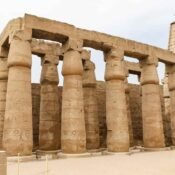
The Colossi of Memnon
If you are looking for a stunning awe-inspiring site, look no further than the Colossi of Memnon. These two huge statues built in Egypt during the 13th century B.C. are an amazing sight to behold. In this blog post, the importance of cool effects is shown.
The Colossi of Memnon
The Colossi of Memnon (Arabic: el-Colossat or es-Salamat) are two massive stone statues of the Pharaoh Amenhotep III, which stand at the front of the ruined Mortuary Temple of Amenhotep III, the largest temple in the Theban Necropolis, near to valley of the kings. They have stood since 1350 BC, and were well known to ancient Greeks and Romans, as well as early modern travelers and Egyptologists. The statues contain 107 Roman-era inscriptions in Greek and Latin, dated to between AD 20 and 250; many of these inscriptions on the northernmost statue make reference to the Greek mythological king Memnon, whom the statue was then – erroneously – thought to represent.
Scholars have debated how the identification of the northern colossus as “Memnon” is connected to the Greek name for the entire Theban Necropolis as the Memnonium.
Colossi of Memnon’s Description
The twin statues depict Amenhotep III (fl. 14th century BC) in a seated position, his hands resting on his knees and his gaze facing eastwards (actually ESE in modern bearings) towards the river. Two shorter figures are carved into the front throne alongside his legs: these are his wife Tiye and mother Mutemwiya. The side panels depict the Nile god Hapi.
The statues are made from blocks of quartzite sandstone which was quarried at el-Gabal el-Ahmar (near modern-day Cairo) and transported 675 km (420 mi) overland to Thebes (Luxor). The stones are believed to be too heavy to have been transported upstream on the Nile. The blocks used by later Roman engineers to reconstruct the northern colossus may have come from Edfu (north of Aswan). Including the stone platforms on which they stand – themselves about 4 m (13 ft) – the colossi reach 18 m (60 ft) in height and weigh an estimated 720 tons each. The two figures are about 15 m (50 ft) apart.
Both statues are quite damaged, with the features above the waist virtually unrecognizable. The southern statue comprises a single piece of stone, but the northern figure has a large extensive crack in the lower half and above the waist consists of 5 tiers of stone. These upper levels consist of a different type of sandstone, and are the result of a later reconstruction attempt, which William de Wiveleslie Abney attributed to Septimius Severus. It is believed that originally the two statues were identical to each other, although inscriptions and minor art may have varied.
The original function of the Colossi was to stand guard at the entrance to Amenhotep’s memorial temple (or mortuary temple): a massive construct built during the pharaoh’s lifetime, where he was worshipped as a god-on-earth both before and after his departure from this world. In its day, this temple complex was the largest and most opulent in Ancient Egypt. Covering a total of 35 hectares (86 acres), even later rivals such as Ramesses II’s Ramesseum or Ramesses III’s Medinet Habu were unable to match it in area; even the Temple of Karnak, as it stood in Amenhotep’s time, was smaller.
With the exception of the Colossi, however, very little remains today of Amenhotep’s temple. It stood on the edge of the Nile floodplain, and successive annual inundations gnawed away at its foundations – a 1840s lithograph by David Roberts shows the Colossi surrounded by water – and it was not unknown for later rulers to dismantle, purloin, and reuse portions of their predecessors’ monuments.
Roman era inscriptions
The statues contain 107 Roman-era inscriptions in Greek and Latin, dated between 20-250CE; these inscriptions allowed modern travellers to connect the statues to the classical Greek and Latin literature. Many of the inscriptions include the name “Memnon”.
They were first studied in detail by Jean-Antoine Letronne in his 1831 La statue vocale de Memnon considérée dans ses rapports avec l’Égypte et la Grèce and then catalogued in the second volume (1848) of his Recueil des inscriptions grecques et latines de l’Égypte.
Recent Posts
Luxor day tour: Most Illuminated Temples
Discover Luxury Nile Cruises
Designing the Perfect Itinerary for Your Nile Cruise




